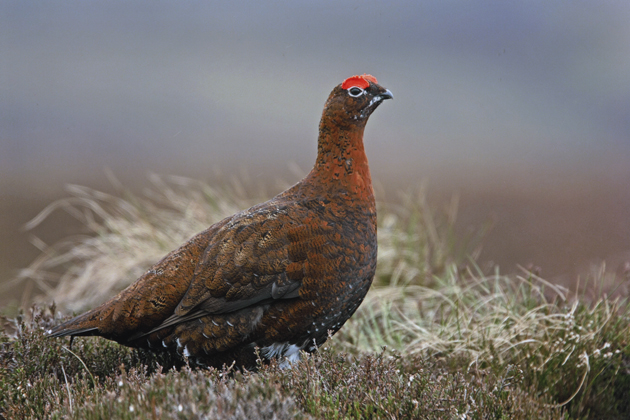About
The Red Grouse survey began in 2011 and runs for six weeks each spring. It was adopted by the SACWG in 2012, as many members already participated in the project.
The aim is to record males defending their territories on the Long Mynd tops around sunset. Population estimates were 63-66 territorial males in 2012, 53-54 in 2013, 56-58 in 2014, and 57-59 in 2015. It appears that numbers were hit by the bad weather in early spring in 2013, but recovered a bit in 2014 and 2015. There were not enough observations of territorial activity in 2016 to produce an estimate, but there were at least 42.
In 2017, at least 49 territories were identified but this number may have been depressed by poor weather on some of the count days. The survey was repeated in 2018, resulting in the highest count to date, an estimated 64-66 territorial males. In 2019 an estimated 54 territorial males were counted, but there was a low level of Grouse activity on the dates when the southern part of the hill was surveyed, and there were probably a few more.
The 2020 survey was cancelled, because of the coronavirus lockdown restrictions Surveys were organised in 2021 and 2022, but results were inconclusive.
By 2023 there was anecdotal evidence that the grouse population has actually declined substantially, so the 2023 survey results have been analysed. Again, the weather wasn’t ideal, but it was probably not much different from years before 2019. There are obviously caveats, and the results are probably less robust as there is less need for grouse to display to defend their territories if density is lower, but the result was 32-33 territorial males (half the maximum estimates of 5-10 years ago).
A survey is therefore particularly important this year, to establish if the population has really halved. Possible explanations include
- the heather is generally still in poorer condition following the outbreak of heather beetle and heather die-back in 2018, with less foliage.
- planned management of heather by cutting or burning has fallen behind schedule Increases in the amount of Bracken, and encroachment onto the heathland plateau
- localised high grazing levels has reduced the amount of flowering heather in some areas
- disease and increased predation
- increased human disturbance, particularly by dogs off leads.
ANNUAL REPORTS
If you would like to read more about the objectives, methods and results of the Red Grouse count, see the download links for years 2012 to 2021. Note that there was no survey in 2020, and no report was produced in 2022, because of inadequate Grouse activity to analyse.
The 2023 report will be available shortly.
Annual reports include the cumulative results from previous years.
The documents are in PDF format.
REPORTS for download
- Red Grouse Count Report for 2012
- Red Grouse Count Report for 2013
- Red Grouse Count Report for 2014
- Red Grouse Count Report for 2015
- Red Grouse Count Report for 2016
- Red Grouse Count Report for 2017
- Red Grouse Count Report for 2018
- Red Grouse Count Report for 2019
- Red Grouse Count Report for 2021
GETTING INVOLVED in 2024
Most territories are within sight and hearing distance of the road along the top, between the Gliding Station and the Shooting Box car park. The display flight is noisy, conspicuous and unmistakeable, and can be observed over long distances, so this is a suitable project for anyone interested in birds or conservation, or who would enjoy the Long Mynd at sunset. No special knowledge or skills are needed.
For more information about the survey, download the Recruiting Leaflet (PDF document). If you want to get involved, please click here to download the editable Participants Form (Word format #), fill it in, and send it to Joe Gomme, preferably by email (joegomme@gmail.com), or post to 52 Queen Street, Shrewsbury, SY1 2JR
There will be a briefing meeting for new participants at 7.30pm on Thursday 28th March 2024 at the National Trust Tearoom in Cardingmill Valley.
# Please note that when you click the Participants Form link, the editable document will be downloaded to your usual download location.
If you have any enquiries about the survey, please contact Joe Gomme at joegomme@gmail.com
